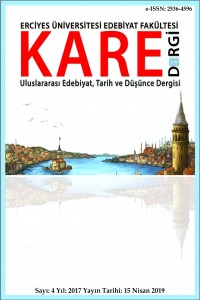Abstract
Bu
çalışmada; XXI yüzyıl hem çağdaş Rus edebiyatının hem de İsrail edebiyatının en
önemli kadın temsilcilerinden biri olarak kabul edilen Dina Rubina’nın
romanları ele alınacaktır.
Yazar
her romanında; romanın yapısı ve konusuna bağlı olarak farklı dil, üslup ve anlatım
tekniği kullanmıştır. Taşkent’te dünyaya gelen yazar, önce Rusya’da daha
sonralar İsrail’de yaşamını sürdürmüş, yaşadığı ülkelerdeki insanların sosyal
ve kültürel yaşamları, gelenek, görenek ve adetleri, dini inanışları, kullanmış
oldukları farklı diller, yazara edebi sanatında eşlik etmiş, yazar bu kaynaktan
ustaca yararlanmıştır. Örneğin, Rubina edebi sanatının belki de en belirgin
özelliklerinden biri eserlerinde genellikle farklı dillerde cümleler; atasözleri
ve deyimleri kullanmasını tercih etmesidir.
Çalışmada
yazarın büyük çaplı eserleri incelenerek yazarın romanlarına has birçok özellik
örneklerle birlikte ele alınacaktır.
Keywords
References
- Rubina, D.İ., Poçerk Leonardo, M.:Eksmo, 2012. Rubina, D.İ.; Poslednıy kaban iz lesov Pontevedra, M.:Eksmo, 2002.Rubina, D.İ.; Sindikat, M.:Eksmo, 2006.Rubina, D.İ.; Sindrom Petruşki, M.:Eksmo, 2008.Rubina, D.İ.; Vot İdet Messiya! SPB., Retro, 1999.Rubina, D.İ; Belaya golubka Kordovı, M.:Eksmo, 2009. Rubina, D.İ.; Na solnetçnoy storone, M.:Eksmo, 2008.
Abstract
This work consists of
the research of novels by Dina Rubina – one of the most important female
representatives of both Russian and Israeli Modern Literatures. Dina Rubina
uses different language, style and narration techniques in every novel, depending
on each novel’s structure and topic. Born in Tashkent, the writer lived in
Russia and then moved to Israel. Thanks to his acquaintance with different
customs and traditions, religious beliefs, various languages and socio-cultural
life styles of the countries she lived in, Rubina uses her immense knowledge of
culture masterfully and reflects this background in almost all novels. For
instance, she prefers using proverbs, sayings and sentences in different
languages – a feature that is the most remarkable one in her literary works.
This research work studies Rubina’s large-scale literary works and presents
many peculiarities of her novels together with examples.
Keywords
References
- Rubina, D.İ., Poçerk Leonardo, M.:Eksmo, 2012. Rubina, D.İ.; Poslednıy kaban iz lesov Pontevedra, M.:Eksmo, 2002.Rubina, D.İ.; Sindikat, M.:Eksmo, 2006.Rubina, D.İ.; Sindrom Petruşki, M.:Eksmo, 2008.Rubina, D.İ.; Vot İdet Messiya! SPB., Retro, 1999.Rubina, D.İ; Belaya golubka Kordovı, M.:Eksmo, 2009. Rubina, D.İ.; Na solnetçnoy storone, M.:Eksmo, 2008.
Details
| Primary Language | Turkish |
|---|---|
| Subjects | Creative Arts and Writing |
| Journal Section | Research Article |
| Authors | |
| Publication Date | April 15, 2019 |
| Submission Date | February 20, 2019 |
| Published in Issue | Year 2017 Issue: 4 |
This journal is licensed under a Creative Commons Attribution 4.0 (Attribution-NonCommercial-NoDerivs 4.0 International (CC BY-NC-ND 4.0) International License.


